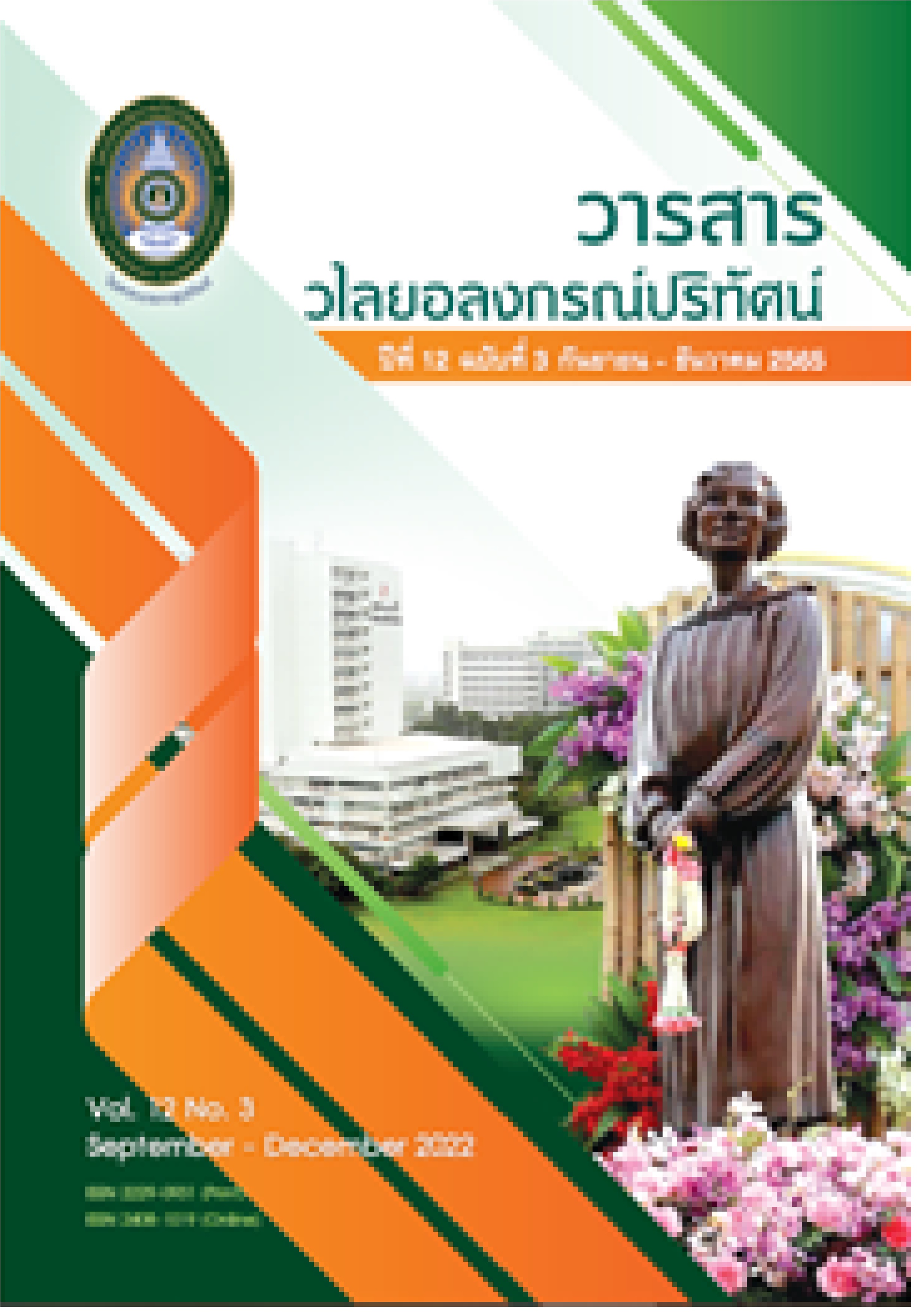การออกแบบธีมเพื่อสร้างประสบการณ์อีเวนต์
คำสำคัญ:
การออกแบบอีเวนต์, ธีมอีเวนต์, ประสบการณ์อีเวนต์, องค์ประกอบของธีมบทคัดย่อ
การเปลี่ยนแปลงเข้าสู่ยุคเศรษฐกิจประสบการณ์ทำให้การออกแบบอีเวนท์มีบทบาทเพิ่มขึ้นทั้งในด้านการสร้าง และการเพิ่มประสิทธิภาพของประสบการณ์ให้กับผู้เข้าร่วม ทั้งนี้ไม่อาจปฏิเสธได้ว่าธีมอีเวนต์ถือเป็นองค์ประกอบสำคัญของการออกแบบที่ช่วยสร้างอัตลักษณ์และกำหนดแนวทางในการออกแบบองค์ประกอบอื่น ๆ ซึ่งในปัจจุบันการจัดอีเวนต์แทบทุกประเภท ตั้งแต่ อีเวนต์ส่วนบุคคลขนาดเล็ก ไปจนถึง อีเวนต์ขนาดใหญ่ระดับประเทศ ต่างมีการกำหนดธีมงานทั้งสิ้น อย่างไรก็ตามงานวิชาการที่เกี่ยวข้องการออกแบบธีมอีเวนต์ยังมีจำนวนน้อยและไม่ได้กล่าวถึงแนวทางที่นำไปสู่ประสบการณ์อันน่าประทับใจของผู้เข้าร่วม บทความนี้จึงมุ่งนำเสนอมุมมองด้านการออกแบบธีมเพื่อสร้างประสบการณ์อีเวนต์ โดยพบว่า 3 ปัจจัยหลักที่ควรนำมาพิจารณาเพื่อการออกแบบธีมอีเวนต์อย่างมีคุณภาพนั้น ได้แก่ 1) ประสบการณ์อีเวนต์ 2) ธีมอีเวนต์ และ 3) องค์ประกอบของธีม บทสรุปของบทความสามารถนำไปต่อยอดในเชิงวิชาการเพื่อสร้างแนวทางการออกแบบธีมเพื่ออีเวนต์แต่ละประเภทในบริบทที่แตกต่างกัน และเป็นแนวทาง ให้กับผู้จัดงาน และนักออกแบบ ในการพัฒนาธีมงานเพื่อสามารถสร้างประสบการณ์ที่น่าประทับใจและนำไปสู่ความสำเร็จของอีเวนต์
เอกสารอ้างอิง
Allen, J., Harris, R., Jago, L., Tantrai, A., Jonson, P. & D'Arcy, E. (2019). Festival and special event management. Queensland: John Wiley & Sons.
Antchak, V. & Adams, E. (2020). Unusual venues for business events: key quality attributes of museums and art galleries. International Journal of Tourism Cities. 6(4): 847-862.
Antchak, V. & Ramsbottom, O. (2019). The fundamentals of event design. New York: Routledge.
Berridge, G. (2010). Event pitching: The role of design and creativity. International Journal of Hospitality Management. 29(2): 208-215.
Biaett, V. & Richards, G. (2020). Event experiences: measurement and meaning. Journal of Policy Research in Tourism, Leisure and Events. 12(3): 277-292.
Bitner, M. J. (1992). Servicescapes: The impact of physical surroundings on customers and employees. Journal of Marketing. 56(2): 57–71.
Brown, S. & James, J. (2004). Event design and management: Ritual sacrifice. Festivals and Events Management. 53-64.
Candi, M. & Beltagui, A. (2015). Designing services that sing and dance. In Design Thinking: New Product Development Essentials from the PDMA. (221-236). John Wiley & Sons.
Charles, M. (2017). Exploring the effect of event design and theming on enhancing attendees experience using boomtown fair as a case study. Doctoral dissertation. Cardiff Metropolitan University. [Online], Available: https://ec2-52-208-36-40.eu-west-1.compute.amazonaws.com/bitstream/handle/10369/8697/Megan%20Charles%20Dissertation.pdf?sequence=1&isAllowed=y (2022, 3 March)
Duerden, M. D., Lundberg, N. R., Ward, P., Taniguchi, S. T., Hill, B., Widmer, M. A. & Zabriskie, R. (2018). From ordinary to extraordinary: A framework of experience types. Journal of Leisure Research. 49(3-5): 196-216.
Ferdinand, N. & Kitchin, P. (2017). Events management: An international approach. (2nd ed.). London: Sage.
Getz, D. & Page, S. (2016). Event studies: theory, research and policy for planned events. (3rd ed.). Routledge: Oxon.
Haeckel, S. H., Carbone, L. P., & Berry, L. L. (2003). How to lead the customer experience. Marketing Management. 12(1): 18-18.
Kuiper, G., & Smit, B. (2014). Imagineering: Innovation in the experience economy. Willingford: CABI.
Liu, Y., & Draper, J. (2022). The Influence of Attending Festivals with Children on Family Quality of Life, Subjective Well-being, and Event Experience. Event Management. 26(1): 25-40.
Matthews, D. (2015). Special event production: The resources. (2nd ed.). London: Routledge.
McCartney, G. (2010). Event management: an Asian perspective. Singapore: McGraw-Hill Education (Asia).
Nelson, K. B. (2009). Enhancing the attendee's experience through creative design of the event environment: applying Goffman's dramaturgical perspective. Journal of Convention & Event Tourism. 10(2): 120-133.
Nordvall, A., Pettersson, R., Svensson, B., & Brown, S. (2014). Designing events for social interaction. Event Management. 18(2): 127-140.
Orefice, C. (2018). Designing for events: A new perspective on event design. International Journal of Event and Festival Management. 9(1): 20–33.
Pine, B. J., & Gilmore, J. H. (1998). Welcome to the Experience Economy. Harvard Business Review. 76(4), 96–105.
Pine, B. J., & Gilmore, J. H. (2011). The Experience Economy. Boston: Harvard Business Press.
Richards, G. (2017). Measuring event experiences: An international view. Expediencies turísticas de festivales y eventos. 11-27
Silvers, J. R. (2007). Analysis of the international EMBOK model as a classification system. In Proceedings of 2007 Las Vegas International Hospitality and Convention Summit. Las Vegas: University of Nevada.
Stein, A., & Ramaseshan, B. (2016). Towards the identification of customer experience touch point elements. Journal of Retailing and Consumer Services. 30: 8-19.
Swaminathan, D. (2018). The art of building experiential events: An event designer’s almanac. Chennai: Notion Press.
ดาวน์โหลด
เผยแพร่แล้ว
รูปแบบการอ้างอิง
ฉบับ
ประเภทบทความ
สัญญาอนุญาต
ลิขสิทธิ์ (c) 2022 จิตสุภา เมืองแมน, เกิดศิริ เจริญวิศาล, จิตพนธ์ ชุมเกตุ

อนุญาตภายใต้เงื่อนไข Creative Commons Attribution-NonCommercial-NoDerivatives 4.0 International License.
ข้อความที่ปรากฏในบทความแต่ละเรื่องในวารสารวไลยอลงกรณ์ปริทัศน์ เป็นความคิดเห็นของผู้นิพนธ์แต่ละท่าน มิใช่เป็นทัศนะและมิใช่ความรับผิดชอบของกองบรรณาธิการจัดทำวารสาร และ
มหาวิทยาลัยราชภัฏวไลยอลงกรณ์ ในพระบรมราชูปถัมภ์


